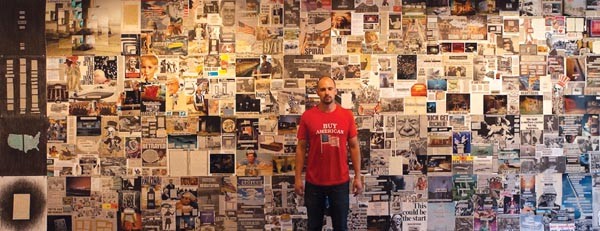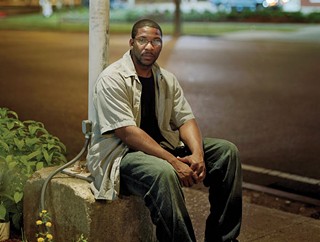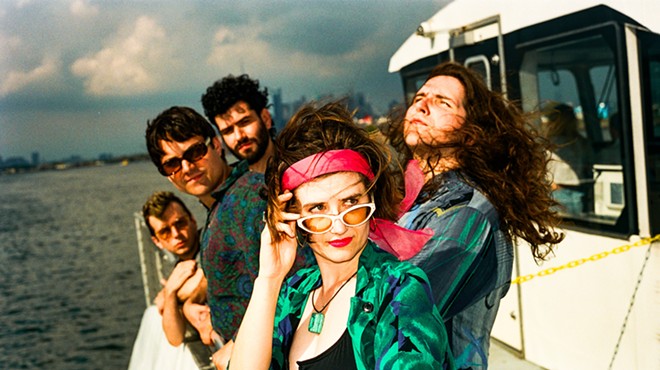Will Steacy's 170-foot collage is the dominating presence in his exhibit No Job No Home No Peace No Rest. The show's title is taken from Bruce Springsteen's song "The Ghost of Tom Joad," which refers to the protagonist of John Steinbeck's The Grapes of Wrath. (I know you already knew that.) Steacy's giant collage is a big response to a huge problem, namely the erosion of the American Dream during the past three decades and the effects on those being left behind. The exhibit also includes 32 color photographs from Steacy's series Down These Mean Streets, All My Life I Have Had the Same Dream and We Are All in This Together — titles that convey his concern for the plight of the forgotten and the dispossessed.
Co-curated by Silver Eye executive director Ellen Fleurov and independent curator (and occasional CP contributor) Leo Hsu, Steacy's collage pushes the boundaries at Silver Eye without diminishing the gallery's focus on photography. Currently dividing his time between Philadelphia and New York, Steacy is a photographer of considerable skill, profound commitment, and accomplishment in publications, exhibitions and awards. He's also pissed off and wants to tell us why.
Photographs such as "Rubble, Detroit" (2009) and "Couch, San Francisco" (2010) are not only documentary records of place and time but also, in conjunction with the other photographs here, testaments to the poverty and despair permeating many inner-city neighborhoods. Depicted are mostly nocturnal scenes of uncollected trash, nihilistic graffiti and people who appear to not be getting the help they need. It adds up to a nightmarish vision of neighborhoods stranded with a minimum of education, jobs and social services.
Steacy recognizes that while photography is invaluable for showing how things look, and can serve a symbolic or even iconic role, the medium is limited in what it can communicate. (All this per his Sept. 12 talk at Spaces Corners photography bookstore.) In seeking to get beyond the all-too-real appearance of foreclosed homes, shuttered factories and homeless people, news junkie Steacy went through his collection of newspapers and magazines in order to trace a path through journalistic stories that addressed the roots of the crisis as well as its effects.
Incorporating headlines and press photographs along with photographs by Steacy himself, the 2012 collage "The Beast" is a broad survey of, and strident commentary on, economic policies and outcomes over the past 30-plus years. It spans the wishful thinking of Reagan's trickle-down theory; the deindustrialization of America under free trade/globalization; ramped-up militarism and surveillance after 9/11; and greed and misdeeds in the financial industry. The collage encompasses everything from statistics to personal stories, expressing empathy, assigning blame and, by implication, elegizing a time of an at least somewhat more fair economic order. Steacy's disdain is by no means confined to Republicans, though they do appear to merit more than their share of blame.
Utilizing an approach first developed in early-20th-century Dada collage, Steacy combines words and images confrontationally, yet in a way that mostly remains true to their intent as published. "The Beast" is a kind of timeline and journal, stepping outside the confines of reporting to present an overview of cumulative assaults on the American Dream of economic mobility and middle-class prosperity. Laid out as two-page spreads in a book-ready format — a book is forthcoming — here they are abutted into a giant mass, gaining an authority of scale while diminishing readability and coherence.
I can't imagine anyone entirely taking in the thousands of clippings with words in the tens of thousands — at least not while standing in a gallery. But as is, it's a strain to follow threads very far. It might feel different in a book that could be perused in sections. Here the primary effect is that of an impassioned plea, a vast outpouring in which the artist, based on his research and experience, expresses his shock and disgust at the policies and practices that have increasingly burdened and left behind America's most vulnerable.
Steacy is equal parts documenter and provocateur. Given the depth of his concern, it's no surprise that Steacy is angry, and that emotion suffuses the exhibit. My feeling is that any thoughtful, informed contribution to the conversation can only help, but if you're looking for a glimmer of hope and some practical direction, you might try Amy Goodman at Democracy Now!
















